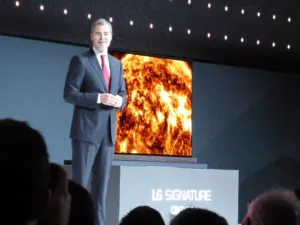We spent a lot of time with Neil Robinson, whom we met last year, LG’s director of technology partnerships. He has an excellent understand of HDR and OLED technology, and we were thankful to him for taking the time to walk round the stand with us.
HDR is not simply a measure of contrast ratio; you also need to work on the relative difference between light and dark areas. HDR displays must have accurate mid-tones and preserve the ratio between these and shadowed areas. Mid-tones are important as they are what people see the majority of the time: materials like wood, plastic and skin.
The discussion then turned to content mastering. Hollywood uses 32″ or 40″ displays for its chroma and luminance mastering; simple duplication of this mastering is not good enough for content owners, as their content will be played on a huge variety of screen sizes and resolutions. Brightness, for example, can be lower on smaller displays and still have the same impact.
Last year, LG’s OLEDs achieved 400 cd/m² at CIE D65; this year, that has increased to 600 cd/m². It is a relatively small increase – half an f stop – but has a large perceived increase.
There has been some disagreement on how brightness is handled. If, for example, content is mastered at 1,000 cd/m², and shown on a 400 cd/m² display, Hollywood’s original guidance was to show the first 400 cd/m² and then clip everything else. Now, they are saying that the system should show the first 300 cd/m² and compress everything else into the remaining brightness range. Again, due to the number of different types of screen that content will be shown on, this is difficult to do.
Dolby has experience in tone-mapping and compression, but will not share this with non-partners. This was part of the reason that an agreement, to put Dolby Vision HDR onto LG’s 2016 TVs, was signed. Another reason – Robinson feels – had to do with backlight technology.
There is a problem with backlight control in LCD sets: it is reactive. The screen and backlight do not communicate instantaneously; instead, there is a delay of as much as 0.5 seconds before the backlight changes to adjust to what is on the display. This causes artefacts such as ghosting.
Robinson suspects that Dolby, which acquired Brightside Technologies several years ago, has a patent for active backlight adjustment. This would allow the backlight to ‘know’ what is coming in the next frame, and to instantly adjust. Although no-one has said as much outright, Robinson said that the technology is not difficult, but no-one is doing it – aside from those companies who are Dolby partners. Draw your own conclusions!
As well as Dolby Vision, LG’s 2016 OLED TVs use the HDR-10 format. They may use the BBC’s hybrid log gamma (HLG) approach in the future, but more work needs to be done; there is no signalling on HDMI or metadata on HEVC to indicate that the system is HLG, at present. VESA is also required to be involved, for EDID. This is all happening “behind the scenes”, said Robinson.
It seems likely that, as we have predicted in the past, Dolby Vision HDR will be used exclusively on high-end sets. LG’s high-end models (both OLED and LCD) use Dolby Vision and HDR-10, but the more mainstream units use HDR-10 (we saw similar approaches from multiple other TV makers).
We heard that US broadcasters are not fond of the hybrid log gamma approach, and have asked LG for clarification on this point.

